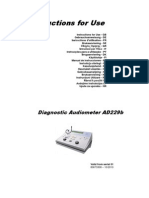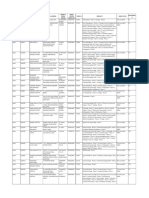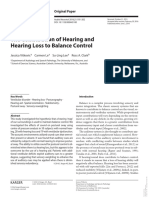AD229e Operation Manual P5
AD229e Operation Manual P5
Uploaded by
Rafael TejedaCopyright:
Available Formats
AD229e Operation Manual P5
AD229e Operation Manual P5
Uploaded by
Rafael TejedaOriginal Description:
Copyright
Available Formats
Share this document
Did you find this document useful?
Is this content inappropriate?
Copyright:
Available Formats
AD229e Operation Manual P5
AD229e Operation Manual P5
Uploaded by
Rafael TejedaCopyright:
Available Formats
If the ear has a middle ear loss, the masking intensity should
be increased by this loss as the masking to the masked ear is
AC sound, which of course will be damped by the AC-BC loss
in the masked ear.
If the BC tone is set to 50 dB, the minimum masking intensity
will be 50 dB to the masked ear without middle ear loss: 50 dB
- (0 to 5)dB = 45 to 50 dB.
If the masked ear has an Air Bone loss of 20 dB, the minimum
masking will be: 50 dB - (0 to 5) dB + 20 dB = 65 to 70 dB.
Maximum masking:
Maximum masking is the highest level of masking intensity
which does not change the true threshold of the test ear.
When ears with large AC-BC gaps are tested, the audiologist
must be aware of the masking dilemma where minimum
masking becomes over-masking without finding the plateau
where the masking is correct.
For AC tests: Tone AC + 50 dB
For BC tests. Tone BC + 50 dB.
Masking using insert earphones:
A more efficient masking can be obtained by using an insert
earphone (hearing aid earphone) for masking instead of the
TDH39 earphone.
This insert earphone is equipped with a suitable ear tip and
inserted into the ear canal of the masked ear. Otherwise, the
masking procedure is the same. As the test ear is open during
the BC test with insert masking, it is important that the test is
performed in a sound cabin with no background noise.
When masking is supplied via normal TDH39 earphones
during the BC test, the earphone over the test ear can be
moved a little forward, letting the ear open. This will prevent
the so-called occlusion effect at lower frequencies, especially
125-750 Hz. In practise, this effect can be regarded as less
important.
AD229e Operation Manual Page 19
Masking Procedure - Step by Step (Hoods
Plateau)
In air and bone conduction measurements the hearing threshold
levels of both ears are determined separately. Therefore, under
specified conditions, masking noise shall be applied to the ear not
being tested (contra lateral ear).
A) Find the unmasked thresholds for air conduction and then for
the better ear by bone conduction - see air and bone
conduction.
B) Notify the subject that masking will be used. Tell him that he
will be hearing some noise, but to disregard it as best as he
can and respond only to the test signal, as he did previously.
When air conduction is made, both ears are covered by earphones.
The noise is presented through one earphone and the test signal
through the other.
When bone conduction is made, the noise is presented through one
earphone placed on the non-test ear. The other earphone is placed
in front of the test ear and thereby not covering the ear. The bone-
conduction vibrator is placed on the mastoid process of the test ear.
C) Select input: Tone and output: "Right" (11), "Left" (12) or
"Bone R L" (13). Turn “HL dB” (22) to the right and the
masking noise will automatically be activated. Set the “HL dB”
(19) rotary switch to the test ear at the level of the unmasked
threshold by means of rotary switch.
D) Increase the masking in 10 dB steps by means of the rotary
switch for channel 2 (allow approx. 2 seconds at each step),
and have the subject letting you know when he first starts to
hear the noise.
E) When the subject indicates that he hears the noise, the test
begins.
AD229e Operation Manual Page 20
F) Begin the threshold shift procedure from this starting point (the
“HL dB” (19) dial set to the unmasked threshold level for the
test ear, and the masking at the point it is first heard by the
subject).
G) Present the test tone. If the subject hears it, as indicated by
pressing the push button, increase the noise 10 dB and
present the test tone again. Continue the procedure as
follows:
- Whenever the test tone is heard, increase the masking 10
dB.- Whenever the test tone is not heard, increase its level
in 5 dB steps until it is heard.
- Continue the procedure until a sequence occurs where the
threshold remains the same over a series of masking noise
increases. This level is equivalent to the "Plateau" and the
tone stimulus level can be considered to be the threshold
for the frequency under test.
An option is to continue increasing the masking level until over-
masking occurs. Over-masking will be very noticeable because when
this level is reached, each 10 dB increase in noise will result in a 10
dB increase in threshold. Caution must be exercised in air
conduction testing because over-masking may not occur. This will be
true especially when the unmasked results actually represented the
true thresholds. In this case, the threshold may not change even
over a very wide range of noise levels. Over-masking is much more
likely to occur in Bone Conduction testing.
H) As soon as the masked threshold has been determined,
reduce the noise to a level below the subject's threshold.
I) Record masked thresholds with appropriate symbols. Do not
record both the unmasked and masked results. In addition,
indicate the type of noise utilised and the upper level of the
noise when the masked threshold was determined.
AD229e Operation Manual Page 21
Speech Presentation
Select “Mic” (3) for live voice speech testing, or select “Tape 1/2” (4)
for presentation of pre-recorded speech material.
A) Select desired test ear / transducer (11, 12, 13, 14).
Prior to the actual speech testing the intensity of the speech signal
must be calibrated to match the requirements of the audiometer.
While presenting the speech signal from the CD or Tape or through
the microphone the input controls (G, H and K that are located above
the respective “Mic” (3) and “Tape 1/2” (4) selector must be adjusted
so the maximum deflection on the VU-meter (E) reaches “0”
indication on its scale on the points of maximum intensity of the
spoken words.
B) Select desired level by means of the left “HL dB” (19).
C) Start the audiometric testing.
AD229e Operation Manual Page 22
Automatic Speech Scoring Counter
With AD229e it is possible to perform automatic speech score
calculation. The procedure is the following:
1) Present a word to the patient.
2) Select “Incorrect” (20) or “Correct” (21) according to the
response from the patient.
3) Repeat 1) and 2) until the word list is completed.
4) Correct speech score will be indicated on the screen in e.g.
80% correct responses.
Number of Words
The number of words to be tested must be entered in the
internal setup item no. 24.
Standard Curves
In addition to the standard curves which are defined in the
internal setup item no. 27 (for normal headphones) and no. 28
(for Free Field), up to four separate speech curves per ear
may be entered in the AD229e.
Each curve may be addressed by holding down “shift” (10)
while browsing with the “Frequency” buttons (20, 21).
1 dB attenuator steps
You may choose between attenuator steps of 1 dB or 5 dB on
“dB 1 5” (6).
Masking and Speech
Speech noise as masking may be selected and adjusted by
dialling the right “HL dB” attenuator (22). To switch off
masking, hold down “shift” (10) while dialling the right “HL dB”
attenuator (22) anticlockwise.
AD229e Operation Manual Page 23
You might also like
- The Estill Voice Model - Theory & Translation Elizabeth Ann Benson - Stimme - LinklaterDocument4 pagesThe Estill Voice Model - Theory & Translation Elizabeth Ann Benson - Stimme - LinklaterWinter HeinzNo ratings yet
- Seth Riggs - Vocal Instruction VowelDocument3 pagesSeth Riggs - Vocal Instruction Voweljizzleishish50% (4)
- ARLas CalibrationDocument17 pagesARLas CalibrationJuan Sebas VizueteNo ratings yet
- Instructions For Use: Diagnostic Audiometer AD 226Document172 pagesInstructions For Use: Diagnostic Audiometer AD 226Harold MartinezNo ratings yet
- Lab Manual AVSDocument44 pagesLab Manual AVSKarishma Sav33% (3)
- Audiometro 229 BDocument193 pagesAudiometro 229 BMatias Ivan Toloza MoraNo ratings yet
- Book List of ENTDocument6 pagesBook List of ENTLAKSHIT KUMARNo ratings yet
- Sieber BassDocument19 pagesSieber Basshiderdediaz2009100% (1)
- AD229e Operation Manual P4Document5 pagesAD229e Operation Manual P4Rafael TejedaNo ratings yet
- Noise Level Measurement PRELAB: #01 Group 5Document7 pagesNoise Level Measurement PRELAB: #01 Group 5louryNo ratings yet
- Rehab Tech21Document114 pagesRehab Tech21Appas SahaNo ratings yet
- Industrial Noise ControlDocument5 pagesIndustrial Noise ControlVelpandian ManiNo ratings yet
- Pello BrochureDocument8 pagesPello BrochureNazario Vidal EncisoNo ratings yet
- Chapter 9Document31 pagesChapter 9mahraNo ratings yet
- Hearing ConservationDocument7 pagesHearing ConservationJenil TNo ratings yet
- Audiology MaskingDocument6 pagesAudiology MaskingRavi VarakalaNo ratings yet
- Introduction To Noise Control-FDDocument37 pagesIntroduction To Noise Control-FDReyes SanchezNo ratings yet
- Modified Verification Approaches For Frequency Lowering Devices AudiologyOnlineNov09Document8 pagesModified Verification Approaches For Frequency Lowering Devices AudiologyOnlineNov09Emil Valentin TomaNo ratings yet
- Understanding The Basics of Sound ControlDocument6 pagesUnderstanding The Basics of Sound ControlkarkeraNo ratings yet
- T10 MaskingDocument2 pagesT10 Maskingshel29No ratings yet
- HML MethodDocument14 pagesHML MethodergowNo ratings yet
- Noise ControlDocument18 pagesNoise ControlRonel MNo ratings yet
- Analog & Digital Sound.: Dy - Director (Engg) Nabm-BbsrDocument26 pagesAnalog & Digital Sound.: Dy - Director (Engg) Nabm-BbsrKamal Singh RajputNo ratings yet
- Audio Theory Basics PDFDocument10 pagesAudio Theory Basics PDFGolnaz AfsharNo ratings yet
- Noise Level StandardDocument14 pagesNoise Level StandardSyazwani NasirNo ratings yet
- Hearing Conservation & Noise ExposureDocument23 pagesHearing Conservation & Noise ExposuretuNo ratings yet
- Audio Precision - Application Note: Headphone Electroacoustic MeasurementsDocument26 pagesAudio Precision - Application Note: Headphone Electroacoustic MeasurementsAnonymous 3mJfZENo ratings yet
- Lindab Airductsystems - Presiune AdmisaDocument2 pagesLindab Airductsystems - Presiune AdmisarpufitaNo ratings yet
- AD229e Operation Manual P10Document5 pagesAD229e Operation Manual P10Rafael TejedaNo ratings yet
- AD229e Operation Manual P9Document5 pagesAD229e Operation Manual P9Rafael TejedaNo ratings yet
- WHITHER DITHER: Experience With High-Order Dithering Algorithms in The StudioDocument21 pagesWHITHER DITHER: Experience With High-Order Dithering Algorithms in The Studiojulia4gNo ratings yet
- Ngineering ATA: Fan Sound & Sound RatingsDocument8 pagesNgineering ATA: Fan Sound & Sound RatingsRavi DeshmukhNo ratings yet
- Noise Control Design GuideDocument44 pagesNoise Control Design Guidejorgeblotta3489No ratings yet
- Noise Lecture PDFDocument49 pagesNoise Lecture PDFcristian_iacomi3416No ratings yet
- PTA and TympanometryDocument27 pagesPTA and Tympanometrydykesu1806No ratings yet
- In TheaterDocument4 pagesIn TheaterArchi TectureNo ratings yet
- ES 7, Noise PollutionDocument11 pagesES 7, Noise PollutionSajib IglesiasNo ratings yet
- Sound Measurment and Observation ReportDocument6 pagesSound Measurment and Observation ReportAnonymous Tn5rYd6o4No ratings yet
- Description Sound Level Example Sound Intensity: How Loud Is That?Document2 pagesDescription Sound Level Example Sound Intensity: How Loud Is That?NakkolopNo ratings yet
- INDUSTRIAL ENGG - LAB (Exp-4) 6053RDocument6 pagesINDUSTRIAL ENGG - LAB (Exp-4) 6053Rpatel1029poojaNo ratings yet
- Noise Reduction in Hvac Duct SystemsDocument27 pagesNoise Reduction in Hvac Duct SystemsQOBITNo ratings yet
- Table Chart Sound PressureDocument6 pagesTable Chart Sound PressureMiroslav KaravlaNo ratings yet
- Hearing ProtectionDocument48 pagesHearing Protectionanon_881102163No ratings yet
- True 63Document2 pagesTrue 63stefanygomezNo ratings yet
- Prelab 9 - Sound Levels: Sound Pressure Level MeasurementsDocument4 pagesPrelab 9 - Sound Levels: Sound Pressure Level MeasurementsNadhirah LnfNo ratings yet
- Aud4001 Lecture NotesDocument13 pagesAud4001 Lecture NotesjazmashNo ratings yet
- The Selection of Hearing ProtectionDocument6 pagesThe Selection of Hearing ProtectionVijayakumarVageesanNo ratings yet
- STC 5 - Group 13 - 4 A - Summary - Physical and Psychological Hazards and ControlDocument13 pagesSTC 5 - Group 13 - 4 A - Summary - Physical and Psychological Hazards and ControlVincent Ronin SerratoNo ratings yet
- Fan Sound Sound Ratings Fe 300Document8 pagesFan Sound Sound Ratings Fe 300hardik033100% (1)
- Sound Pressure LabDocument6 pagesSound Pressure LabbugdoNo ratings yet
- Guide To Speech AudiometryDocument16 pagesGuide To Speech Audiometrywaleed yehiaNo ratings yet
- A Presentation On Noise PollutionDocument22 pagesA Presentation On Noise PollutionDinesh Pant100% (1)
- Threshold Equalizing Noise (TEN) - Quick Guide: What Is The TEN Test?Document3 pagesThreshold Equalizing Noise (TEN) - Quick Guide: What Is The TEN Test?Matias CNo ratings yet
- Noise - AnswerDocument36 pagesNoise - AnswerPankaj100% (1)
- What Is An A-Weighted Decibel (DBA or DB (A) )Document4 pagesWhat Is An A-Weighted Decibel (DBA or DB (A) )Sigid AriewibowoNo ratings yet
- Operation Manual AS216Document34 pagesOperation Manual AS216Ytamar Visbal PerezNo ratings yet
- STUDENTS Lecture 3 (Chapter 2)Document29 pagesSTUDENTS Lecture 3 (Chapter 2)Sirine AjourNo ratings yet
- Pure Tone AudiometryDocument13 pagesPure Tone AudiometryDanishyana DhiwaneoNo ratings yet
- Assessment of HearingDocument45 pagesAssessment of HearingRachanaNo ratings yet
- A-Weighted Noise Level (DB)Document9 pagesA-Weighted Noise Level (DB)felisianusNo ratings yet
- Acoustic Treatment - Noise Control: MEBS6008 Environmental Services IIDocument64 pagesAcoustic Treatment - Noise Control: MEBS6008 Environmental Services IIvrgohilNo ratings yet
- Noise Reduction: Enhancing Clarity, Advanced Techniques for Noise Reduction in Computer VisionFrom EverandNoise Reduction: Enhancing Clarity, Advanced Techniques for Noise Reduction in Computer VisionNo ratings yet
- Diagramas MP300Document2 pagesDiagramas MP300Rafael TejedaNo ratings yet
- Diagramas MP300Document2 pagesDiagramas MP300Rafael TejedaNo ratings yet
- Diagramas MP300Document2 pagesDiagramas MP300Rafael TejedaNo ratings yet
- AD229e Operation Manual P6Document5 pagesAD229e Operation Manual P6Rafael TejedaNo ratings yet
- Diagramas MP300Document2 pagesDiagramas MP300Rafael TejedaNo ratings yet
- AD229e Operation Manual P12Document5 pagesAD229e Operation Manual P12Rafael TejedaNo ratings yet
- Diagramas MP300Document2 pagesDiagramas MP300Rafael TejedaNo ratings yet
- AD229e Operation Manual P10Document5 pagesAD229e Operation Manual P10Rafael TejedaNo ratings yet
- AD229e Operation Manual P11Document5 pagesAD229e Operation Manual P11Rafael TejedaNo ratings yet
- AD229e Operation Manual P8Document5 pagesAD229e Operation Manual P8Rafael TejedaNo ratings yet
- AD229e Operation Manual P9Document5 pagesAD229e Operation Manual P9Rafael TejedaNo ratings yet
- AD229e Operation Manual P2Document5 pagesAD229e Operation Manual P2Rafael TejedaNo ratings yet
- AD229e Operation Manual P1Document5 pagesAD229e Operation Manual P1Rafael TejedaNo ratings yet
- Ralco: Operating InstructionsDocument2 pagesRalco: Operating InstructionsRafael TejedaNo ratings yet
- AD229e Operation Manual P3Document5 pagesAD229e Operation Manual P3Rafael TejedaNo ratings yet
- Ralco 3Document2 pagesRalco 3Rafael TejedaNo ratings yet
- Windows ME Driver Installation - Horizon: Technical BriefDocument3 pagesWindows ME Driver Installation - Horizon: Technical BriefRafael TejedaNo ratings yet
- OEC 7900 Spare PartsDocument65 pagesOEC 7900 Spare PartsRafael TejedaNo ratings yet
- Creating CMMS Electronic System Using Excel VBA: July 2020Document4 pagesCreating CMMS Electronic System Using Excel VBA: July 2020Rafael TejedaNo ratings yet
- Macintosh OS X Driver Installation - Horizon: Technical BriefDocument2 pagesMacintosh OS X Driver Installation - Horizon: Technical BriefRafael TejedaNo ratings yet
- Siremobil Compact MaintenanceDocument22 pagesSiremobil Compact MaintenanceRafael Tejeda100% (1)
- Error 4021, 4024 Siremobil CompacDocument4 pagesError 4021, 4024 Siremobil CompacRafael Tejeda100% (3)
- Ear Box QuesDocument9 pagesEar Box QuesRafiq FaisalNo ratings yet
- Meniere's Disease & OtosclerosisDocument44 pagesMeniere's Disease & OtosclerosisNadzirah Ahmad JailaniNo ratings yet
- Ehs Hospitals All StatesDocument85 pagesEhs Hospitals All Statesnaiduu497No ratings yet
- Aural Rehabilitation For AUD and SLTDocument2 pagesAural Rehabilitation For AUD and SLTKamira GovenderNo ratings yet
- Chiranjeevi Jaipur HospitalDocument13 pagesChiranjeevi Jaipur HospitalseyedbrothersNo ratings yet
- 4e8ae48410.TERAPI ISPA DAN ISPBDocument56 pages4e8ae48410.TERAPI ISPA DAN ISPBAbd HarisNo ratings yet
- The PaperDocument13 pagesThe PaperIndriani SinarNo ratings yet
- Common Voice DisordersDocument33 pagesCommon Voice DisordersMedic PresentNo ratings yet
- ENT MCQsDocument13 pagesENT MCQsSheikha100% (2)
- Ear, Nose and Throat emerg-ENT-cies: With Laura WilkinsDocument43 pagesEar, Nose and Throat emerg-ENT-cies: With Laura WilkinsIrina AndreeaNo ratings yet
- Chronic Otitis Media Types, Investigations, TreatmentDocument43 pagesChronic Otitis Media Types, Investigations, TreatmentPrasanna DattaNo ratings yet
- Diseases in Children Word FileDocument12 pagesDiseases in Children Word FileLezrae Chescka Javier IlumbaNo ratings yet
- OTITIS MEDIA - Nov - 2020Document109 pagesOTITIS MEDIA - Nov - 2020NicNo ratings yet
- Respiratory PathophysiologyDocument17 pagesRespiratory PathophysiologyJohn Christopher LucesNo ratings yet
- Voice and Voiceless Paper Fix) - 1Document13 pagesVoice and Voiceless Paper Fix) - 1Wilda FuadiyahNo ratings yet
- AsomDocument40 pagesAsomRachel RiordanNo ratings yet
- CongenitalDocument18 pagesCongenitalMatheus EmmanuelNo ratings yet
- Ent CaseDocument5 pagesEnt CaseJENNIFER JOHN MBBS2020No ratings yet
- MSN Question Bank-Unit 1 - Ent: Long Essay 5MDocument31 pagesMSN Question Bank-Unit 1 - Ent: Long Essay 5Mkiran kumar100% (1)
- What Is Straw PhonationDocument7 pagesWhat Is Straw PhonationJulia Gavrashenko100% (1)
- All Mbbs BooksDocument5 pagesAll Mbbs BooksarslanNo ratings yet
- Making Success: The StandardDocument17 pagesMaking Success: The StandardsalsomanoNo ratings yet
- EmpyemaDocument1 pageEmpyemaprofarmahNo ratings yet
- Diagnostic Referral From Universal Newborn Hearing ScreeningDocument13 pagesDiagnostic Referral From Universal Newborn Hearing Screeningdr.ib979No ratings yet
- The Contribution of Hearing and Hearing Loss To Balance ControlDocument8 pagesThe Contribution of Hearing and Hearing Loss To Balance ControlVinay S NNo ratings yet
- PuberphoniaDocument15 pagesPuberphoniaZaini ZulqarnainNo ratings yet













































































































